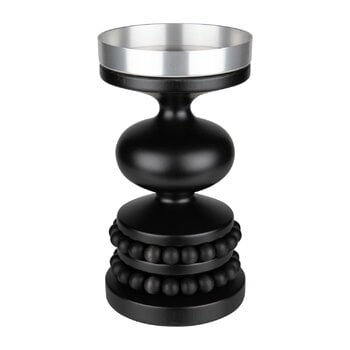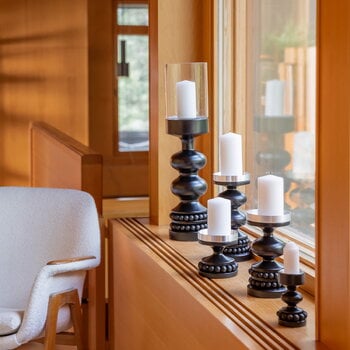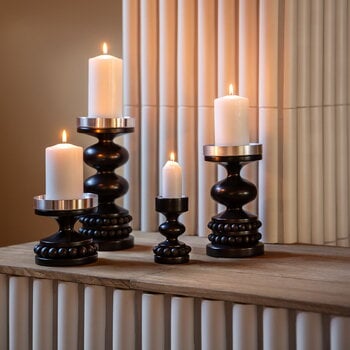Aarikka's Keisarinna candleholder, designed by Kaija Aarikka in 1969, is a striking wooden candlestick featuring hand-turned curves and two wreaths crafted from Aarikka's signature wooden beads. The aluminium top provides a sturdy and secure base for a pillar candle, making it ideal for both special occasions and everyday use. Named after a Finnish word for an empress, the Keisarinna candleholder is handcrafted in Finland.
Keisarinna candleholder, black
Aarikka
Description
Aarikka's Keisarinna candleholder, designed by Kaija Aarikka in 1969, is a striking wooden candlestick featuring hand-turned curves and two wreaths crafted from Aarikka's signature wooden beads. The aluminium top provides a sturdy and secure base for a pillar candle, making it ideal for both special occasions and everyday use. Named after a Finnish word for an empress, the Keisarinna candleholder is handcrafted in Finland.
Product details (7)
- Material
- Birch, maple, aluminium
- Colour
- Black
- Height
- 22 cm
- Diameter
- 12 cm
- Weight
- 0.8 kg
- Care instructions
- Wipe with a dry cloth.
- Notes
- Suitable for a pillar candle with a maximum diameter of 10 cm.
- Product ID
Designer
Kaija Aarikka (1929-2014) is best known for her jewellery and home designs made of wooden beads, designed for Aarikka, a company she founded in 1954 with her husband Erkki Ruokonen. Even though most Aarikka products are made of wood, Kaija Aarikka was very broadminded when it came to experimenting with different materials; she graduated as a textile artist and often used materials like glass or silver in her designs. In 1994, the beloved designer received the prestigious Pro Finlandia Medal and in 1999, she was awarded the Finnish honorary title of ’kauppaneuvos’ by the President of the Republic of Finland.
View all productsReviews (0)
Sustainability
The Product Sustainability Framework, our criteria of sustainable design, helps you find the most sustainable products in our selection. Read below which sustainability criteria this product has met.
Working conditions & labour 9/9
-
Equal opportunities for all employees
-
Commitment to UN Global Compact, fair compensation for all employees
-
Corporate responsibility requirements defined and communicated for suppliers
-
Systematic work for improved inclusion and well-being in the workplace
-
Transparent supply chain
-
Suppliers' compliance to a code of conduct ensured
-
Direct suppliers audited and certified
-
Compliance to the UN Guiding Principles on Business and Human Rights ensured in the supply chain
-
Support for community involvement in the supply chain
Eco-friendly production 7/9
-
Fair and resource-wise water-use in production
-
No incineration or landfilling of returned items
-
No use of endangered species as materials
-
No direct environmental emissions or waste (excl. GHGs) from production
-
The sustainability of direct suppliers' production is addressed and monitored
-
Material-efficient and ecological packaging
-
No potentially harmful chemicals used in own production
-
Production and material sourcing that respect biodiversity, animal rights, and natural ecosystems
-
Positive impact on nature’s well-being through operations that regenerate natural ecosystems
Climate impact 3/8
-
Company's direct greenhouse gas emissions identified and commitment to reduction
-
Product's carbon impact identified and commitment to reduction
-
Guidance on energy- and eco-efficient use of the product
-
Contribution to climate initiatives beyond the brand’s direct operations
-
Low-carbon or compensated transportation
-
Carbon footprint of the product calculated and goals set to reduce it
-
100 % renewable energy in own production and operations
-
Carbon neutral or carbon negative product
Sustainable materials 6/6
-
Sustainable and long-lasting material choices
-
No harmful or hazardous substances
-
Responsible raw material sourcing and production
-
Materials suited for circularity: monomaterials, recyclable finishings, renewable or recycled contents etc.
-
Ecological materials: natural, biodegradable, recyclable or recycled contents
-
Outstanding materials in terms of innovativeness, responsibility, sustainability and circularity: local production or sourcing, 100 % recycled content, C2C-certification etc.
Circular design 4/5
-
High aesthetic quality promoting long-term use of the product
-
Technically durable product design and material choices
-
Design for enduring life-long quality
-
Design and support for product maintenance, repair and upgradability
-
Innovative circular design solutions: circular service system, resale platform, remanufacturing, collection of used products, etc.









